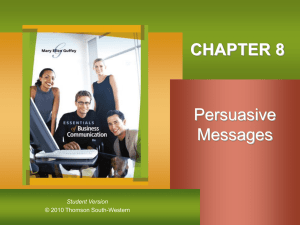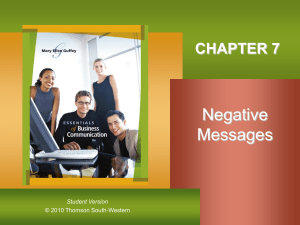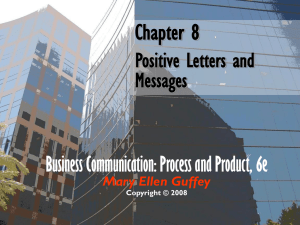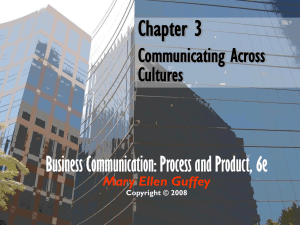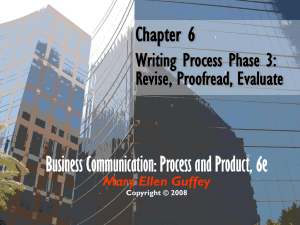Chapter 7 E-Mail Messages and Memos
advertisement
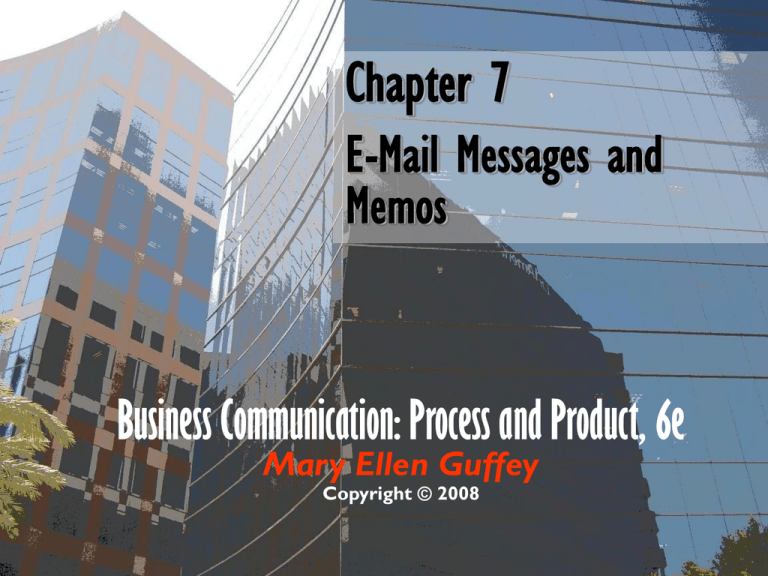
Chapter 7 E-Mail Messages and Memos Business Communication: Process and Product, 6e Mary Ellen Guffey Copyright © 2008 E-Mail Messages and Memos The Writing Process Structure and Format Smart E-Mail Practices Typical E-Mail and Memos Mary Ellen Guffey, Business Communication: Process and Product, 6e Ch. 7, Slide 2 The Writing Process Prewriting Analyze Anticipate Adapt Do I really need to write? E-mail or hard copy memo? Why am I writing? How will the reader react? How can I save the reader’s time? Mary Ellen Guffey, Business Communication: Process and Product, 6e Ch. 7, Slide 3 The Writing Process Writing Research Organize Compose Check files. Collect information. Study relevant documents. Make an outline. Write a first draft. Mary Ellen Guffey, Business Communication: Process and Product, 6e Ch. 7, Slide 4 The Writing Process Revising Revise for clarity. Revise for correctness. Plan for feedback. Edit Proofread Evaluate Mary Ellen Guffey, Business Communication: Process and Product, 6e Ch. 7, Slide 5 E-Mail and Memos: Structure and Format Date: To: From: Subject: 1. Opening 2. Body 3. Closing Mary Ellen Guffey, Business Communication: Process and Product, 6e Ch. 7, Slide 6 E-Mail and Memos: Subject Lines Date: To: From: Subject: New Employee Fitness Center Mary Ellen Guffey, Business Communication: Process and Product, 6e Ch. 7, Slide 7 E-Mail and Memos: Subject Lines Date: To: From: Subject: Your Vacation Request Deadline Mary Ellen Guffey, Business Communication: Process and Product, 6e Ch. 7, Slide 8 E-Mail and Memos: Subject Lines Date: To: From: Subject: Sending Feasibility Report The headline of your memo. Summarize the main idea. Use nouns and phrases, not complete sentences. Mary Ellen Guffey, Business Communication: Process and Product, 6e Ch. 7, Slide 9 E-Mail and Memos: Opening Date: To: From: Subject: 1.Opening Mary Ellen Guffey, Business Communication: Process and Product, 6e Ch. 7, Slide 10 E-Mail and Memos: Opening Start directly; amplify the main idea. Indirect Opening This is to inform you that we must complete the annual operating budgets smoothly. Over the past two months many supervisors have expressed concern about their departmental budget needs. Mary Ellen Guffey, Business Communication: Process and Product, 6e Ch. 7, Slide 11 E-Mail and Memos: Opening Start directly; amplify the main idea. Direct Opening All supervisors and coordinators will meet June 30 at 10 a.m. to work out the annual operating budgets for all departments. Mary Ellen Guffey, Business Communication: Process and Product, 6e Ch. 7, Slide 12 E-Mail and Memos: Body Date: To: From: Subject: 2.Body Mary Ellen Guffey, Business Communication: Process and Product, 6e Ch. 7, Slide 13 E-Mail and Memos: Body Explain and discuss the topic. Introduce relevant details or examples. Use graphic highlighting to enhance reading, comprehension, and retention. Consider columns, headings, numbered or bulleted lists, and so forth. Mary Ellen Guffey, Business Communication: Process and Product, 6e Ch. 7, Slide 14 E-Mail and Memos: Closing Date: To: From: Subject: 3.Closing Mary Ellen Guffey, Business Communication: Process and Product, 6e Ch. 7, Slide 15 E-Mail and Memos: Closing To end the message, you have the following options: Action information Dates or deadlines Summary of the message Closing thought Mary Ellen Guffey, Business Communication: Process and Product, 6e Ch. 7, Slide 16 2 inches from top DATE: TO: FROM: Formatting Hard-Copy 1blank Memos line Current Dawn Stewart, Manager Jay Murray, Vice President Sign your initials SUBJECT: Telephone Service Request Forms 2 blank lines Align items 2 spaces after Subject To speed telephone installation and improve service within the main facility, we are starting a new application procedure. Service request forms will be available at various locations within the three buildings. When you require telephone services, pick up a request form at your nearest location. Fill in the pertinent facts, obtain approval from your division head, and send the form to Brent White. Please call me at 451-0593 if you have any questions about this new procedure. At least 1-inch side margins Mary Ellen Guffey, Business Communication: Process and Product, 6e Ch. 7, Slide 17 DATE: TO: FROM: Current Kim Johnson, Corporate Communications Tim Rudolph, CEO SUBJECT: New Policy “Before”—Ineffective Request Memo This memo is written to inform you that I continue to receive disturbing reports about the misuse of e-mail by employees. In the course of the past three months I have heard of defamatory messages, downloads of pornography for all staff to see, and even a basketball pool that turned into a gambling operation. In view of the foregoing, I am herewith instructing your office that an e-mail policy for the staff is needed. By October 1 a rough draft of a policy should be forthcoming. At the very minimum it should inform each and every employee that e-mail is for business only. Employees must be told that we reserve the right to monitor all messages. No pictures or attachments should be in the e-mail system without there being a valid reason. And we should not be using e-mail to be saying anything about personnel matters—such as performance reviews and salaries. If you have any questions, do not hesitate to call. Mary Ellen Guffey, Business Communication: Process and Product, 6e Ch. 7, Slide 18 Memo Revision: Critical Thinking Questions 1. What is the purpose of the routine request? 2. How effective is the subject line? 3. Is the opening direct or indirect? 4. What does the writer want the reader to do? 5. How should the memo begin? What should be in the body? 6. What highlighting techniques could be used? 7. What should be included in the closing? 8. Should a reason be given along with an end date? Mary Ellen Guffey, Business Communication: Process and Product, 6e Ch. 7, Slide 19 DATE: TO: FROM: Current Kim Johnson, Corporate Communications Tim Rudolph, CEO SUBJECT: Developing Staff E-Mail Policy “After”—Improved Request Memo Please draft a policy outlining appropriate e-mail use for employees. We need a policy because I have received reports of misuse including defamatory messages, pornography downloads, and even gambling. Here are a few points that the policy should cover: E-mail is for business use only. E-mail messages may be monitored. No pictures or attachments should be sent without a valid reason. E-mail should not be used to discuss personnel matters. Please submit a draft to me by October 2 because we hope to have a final policy completed by November 5. Call if you have questions. Mary Ellen Guffey, Business Communication: Process and Product, 6e Ch. 7, Slide 20 Single-space body; double-space between paragraphs. Formatting E-Mail Messages Use angle brackets for Internet addresses Include a salutation for a friendly tone. Dear Dawn: To speed telephone installation and improve service within the main facility, we are starting a new application procedure. Service request forms will be available at various locations within the three buildings. When you require telephone service, pick up a request form at your nearest location. Fill in the pertinent facts, obtain approval from your division head, and send the form to Brent White. Please call me at 451-0593 if you have any questions about this new procedure. Best, Jay Murray, Vice President, Facilities and Operations Phone: (245) 451-0593 ● Fax: (245) 451-3389 E-Mail: jmurray@pro.com Mary Ellen Guffey, Business Communication: Process and Product, 6e Write complete sentences and use upper and lowercase letters. Use a complimentary close and include your contact information. Ch. 7, Slide 21 Smart E-Mail Practices Getting Started Consider composing off line. Type the receiver’s address correctly. Avoid misleading subject lines. Apply the top-of-the screen test. © Ryan McVay / Photodisc / Getty Images Mary Ellen Guffey, Business Communication: Process and Product, 6e Ch. 7, Slide 22 Smart E-Mail Practices Content,Tone, Correctness Be concise. Don’t use e-mail to avoid contact. Care about correctness and tone. Resist humor and tongue-in-cheek comments. Don’t send anything you wouldn’t want published or posted on your office door! Mary Ellen Guffey, Business Communication: Process and Product, 6e Ch. 7, Slide 23 Smart E-Mail Practices Netiquette Limit any tendency to send blanket copies. Never send “spam.” Consider using identifying labels, such as ACTION, FYI, RE, URGENT. Use uppercase only for emphasis or titles. Announce attachments. Seek permission before forwarding. Mary Ellen Guffey, Business Communication: Process and Product, 6e Ch. 7, Slide 24 Smart E-Mail Practices Reading and Replying to E-Mail Scan all messages before replying. Acknowledge receipt. Don’t automatically return the sender’s message. Revise a subject line if the topic in a series of messages (a “thread”) changes. Provide a clear, complete first sentence. Never respond when you are angry. Mary Ellen Guffey, Business Communication: Process and Product, 6e Ch. 7, Slide 25 Smart E-Mail Practices Personal Use Don’t use company computers for personal matters unless allowed by your organization. Assume that all e-mail is monitored, even when you connect to your ISP from work. © George Doyle & Ciaran Griffin / Stockbyte / Getty Images Mary Ellen Guffey, Business Communication: Process and Product, 6e Ch. 7, Slide 26 Smart E-Mail Practices Other Smart Practices Use design to improve readability of longer messages. Consider cultural differences. Double-check before hitting the Send button. Use instant messaging professionally to expand your communication channel choices. Mary Ellen Guffey, Business Communication: Process and Product, 6e Ch. 7, Slide 27 Top Ten Mistakes That Can Sabotage Your Career Responding when angry Making address goofs Forgetting a subject line or failing to change it to match “thread” Not personalizing your message Skipping the salutation and closing identification Mary Ellen Guffey, Business Communication: Process and Product, 6e Ch. 7, Slide 28 Top Ten Mistakes That Can Sabotage Your Career Including inappropriate content Instant indiscretions, off-color jokes, and statements you will later regret Forgetting to check for spelling and grammar Thinking no one else will ever see your e-mail Mary Ellen Guffey, Business Communication: Process and Product, 6e Ch. 7, Slide 29 Top Ten Mistakes That Can Sabotage Your Career Copying and forwarding recklessly Completing “To” line first A slip of the fingers can send a message before its time, and you can never take it back. Expecting an instant response Mary Ellen Guffey, Business Communication: Process and Product, 6e Ch. 7, Slide 30 Sends message to server. a message is that e-mail! Oops! I thought Once Isent, deleted its distribution cannot be controlled. World Sender Serve r and processes Stores Archives messages; a second computer may keep Retain from weeks’duplicates May duplicate, print, to years’ worth of forward, or post the back mail message to the Web Mary Ellen Guffey, Business Communication: Process and Product, 6e Receiver Ch. 7, Slide 31 Typical E-Mail Messages and Memos Request Messages Closing DATE: TO: FROM:Include end date and reason, if SUBJECT: possible. Express appreciation. Opening Frontload your direct request. Body Explain and justify your request. Use Mary Ellen Guffey, Business Communication: Process and Product, 6e Ch. 7, Slide 32 Typical E-Mail Messages and Memos Response Messages Opening Summarize response facts. Body Provide details in a readable form. Closing Offer concluding remark, summary, or further assistance. Mary Ellen Guffey, Business Communication: Process and Product, 6e Ch. 7, Slide 33 Typical E-Mail Messages and Memos Procedural Messages DATE: TO: FROM: SUBJECT: Body Closing Opening Explain Reinforce Announce its need. benefits theList procedure. numbered and provide steps to explain source theofprocedure. further information. Use “command” language (do this; don’t do that). Mary Ellen Guffey, Business Communication: Process and Product, 6e Ch. 7, Slide 34 Typical E-Mail Messages and Memos Confirmation Messages Opening Explain purpose for writing. Body Itemize major issues or points concisely. Include names and titles of involved people. Closing Offer concluding remark, summary, or further assistance. Mary Ellen Guffey, Business Communication: Process and Product, 6e Ch. 7, Slide 35 End Mary Ellen Guffey, Business Communication: Process and Product, 6e Ch. 7, Slide 36
